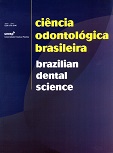Temperature rise and Knoop hardness promoted by different light-curing units
DOI:
https://doi.org/10.14295/bds.2008.v11i1.167Resumo
This study characterized the light emitted by a quartz-tungsten-halogen (QTH) and three light-emitting diode (LED) light curing units (LCUs) and investigated the temperature rise and composite hardness promoted by these sources. XL2500 QTH (3M ESPE), Freelight LED (3M ESPE), Ultrablue Is LED (DMC) and Cool Blue Wand LED (Milestone Scientific) were investigated. The irradiance was measured with a power meter, and the light spectral distribution obtained with a spectrometer. Temperature rise was recorded using a thermocouple connected to a digital thermometer during light-activation of Filtek Z250 (3M ESPE) resin composite. Data were submitted to ANOVA and Tukey’s test (α=0.05). Knoop hardness was assessed at different composite depths (20, 1000 and 1980μm), and data submitted to split-plot design two-way ANOVA and Tukey’s test (α=0.05). Correlation between irradiance and temperature rise was investigated by Pearson’s test. All units presented 95% of irradiance between 400-515nm. Temperature rise means (ºC) varied between 1.05}0.16 and 2.74}0.27. The Cool Blue LED presented significantly higher temperature increase than the other LCUs, and the QTH promoted significantly higher temperature rise than Ultrablue Is and Freelight LEDs. Significant relationship between irradiance and temperature increase was detected (r=0.867; p<0.001). Hardness means (kg/mm2) varied between 40.1}3.6 and 92.7}6.6. Samples activated by the Freelight LED presented significantly lower hardness than samples activated by the others units.
Downloads
Downloads
Publicado
Como Citar
Edição
Seção
Licença
TRANSFERÊNCIA DE DIREITOS AUTORAIS E DECLARAÇÃO DE RESPONSABILIDADE
Toda a propriedade de direitos autorais do artigo "____________________________________________________________________" é transferido do autor(es) para a CIÊNCIA ODONTOLÓGICA BRASILEIRA, no caso do trabalho ser publicado. O artigo não foi publicado em outro lugar e não foi submetido simultaneamente para publicação em outra revista.
Vimos por meio deste, atestar que trabalho é original e não apresenta dados manipulados, fraude ou plágio. Fizemos contribuição científica significativa para o estudo e estamos cientes dos dados apresentados e de acordo com a versão final do artigo. Assumimos total responsabilidade pelos aspectos éticos do estudo.
Este texto deve ser impresso e assinado por todos os autores. A versão digitalizada deverá ser apresentada como arquivo suplementar durante o processo de submissão.




























